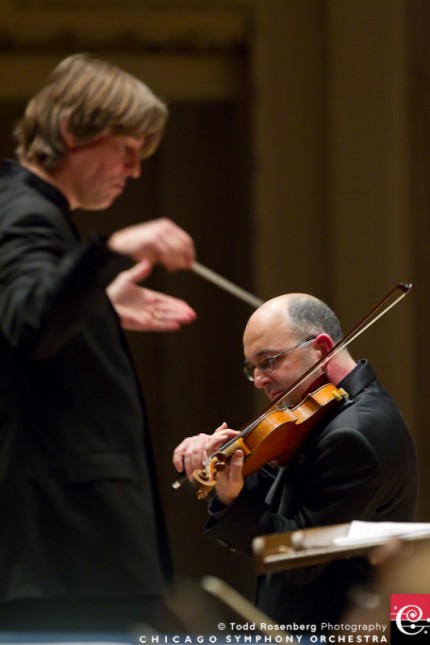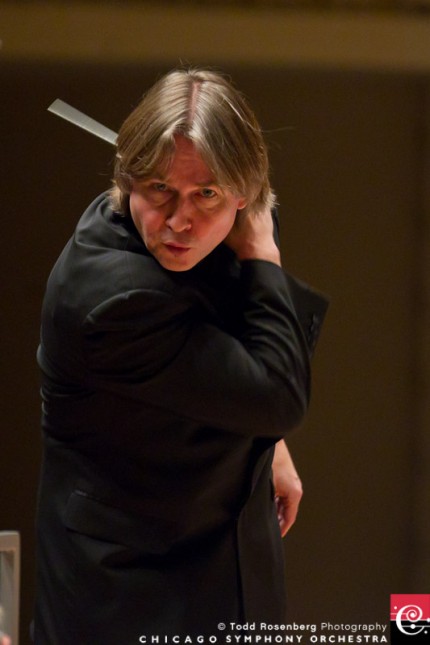Chicago Symphony, Salonen close year with new violin concerto, powerful Mahler

Baird Dodge performed the world premiere of James Matheson's Violin Concerto with Esa-Pekka Salonen conducting the CSO Thursday night at Symphony Center. Photo: Todd Rosenberg.
The Chicago Symphony Orchestra is closing out 2011 with a program marking the Mahler centennial alongside a new work commissioned by the orchestra.
Esa-Pekka Salonen was on the podium Thursday night at Symphony Center for the world premiere of James Matheson’s Violin Concerto, a work co-commissioned by the CSO and Los Angeles Philharmonic, and performed by Baird Dodge.
Scored for large orchestra, Matheson’s 25-minute concerto is cast in the traditional three movements. The opening movement, titled “Caprice,” begins with fast and repetitive Bachian figurations for the soloist. Despite the lightish title, the predominant mood is tense and driven, the restless solo part fitfully contrasted with a lean, austere Sibelius-like lyricism, and punctuated by whipcrack outbursts from the massed orchestra.
As the title suggests, the second movement “Chaconne” is even more indebted to Bach with ruminative variations for the soloist set against a backing line of hushed first violins. The concluding section (“Dance”) breaks in without a pause, ramping up the tempo with accelerating solo virtuosity, the orchestra taking on a syncopated, jazz-like quality on its way to a bravura coda.
Matheson’s concerto has a certain bluff, unpretentious quality to it, but I found the new work lacking in both craft and an individual voice. The extended opening movement lurches from one rhetorical episode to the next without any discernible flow or coherent unfolding argument. The slow movement is the most attractive section but is soon over and the hard-charging finale feels pasted on, sound and fury signifying not so much.
Overall, there’s a superficial slickness to Matheson’s concerto — as in the show-bizzy coda of the Caprice — and the work is over-scored for huge orchestra, heavy on souped-up effects without any deeper argument or expression.
Baird Dodge, the CSO’s principal second violin, gave his friend and former college roommate’s concerto worthy advocacy, some uneven production and fleeting wayward intonation apart. Salonen and his CSO colleagues provided Dodge with alert and tautly focused support.
As part of the CSO’s observation of the centennial year of Mahler’s death, after intermission Salonen led the orchestra in the Austrian composer’s Symphony No. 6.
One of the composer’s most sprawling works, the 80-minute Sixth is the only Mahler work to end pessimistically in complete defeat. The malign, militaristic opening movements have fitful contrasting respites, as with the soaring “Alma” theme of the first. The Andante is one of Mahler’s most open-hearted lyrical inspirations, here given a flowing, non-sticky rendering under Salonen and played with great tonal gleam by the CSO strings. The long finale continually tries to work its way to a hard-won optimistic conclusion only to be felled by two hammer blows of fate (Mahler superstitiously deleted the third in his revised score), the work ending in numbed desolation.

Photo: Todd Rosenberg
Salonen’s approach to this vast score is the antithesis of Bernard Haitink who led the last CSO downtown performances four years ago. As shown on the subsequent recording, whereas Haitink’s reading is more spacious and concerned with immaculate balancing and tonal refinement, Salonen’s approach is impetuous and hard-driven.
At times one wanted greater expressive detailing and elegance in Thursday’s performance which was centered on bristling momentum and full-blooded muscle, veering into coarseness in tuttis.
Still this was an undeniably powerful and magnificently played performance by the orchestra with especially fine contributions from Eugene Izotov, Mathieu Dufour, Stephen Williamson, Jay Friedman and (mostly) Dale Clevenger.
The program will be repeated 1:30 p.m. Friday and 8 p.m. Saturday. cso.org; 312-294-3000.